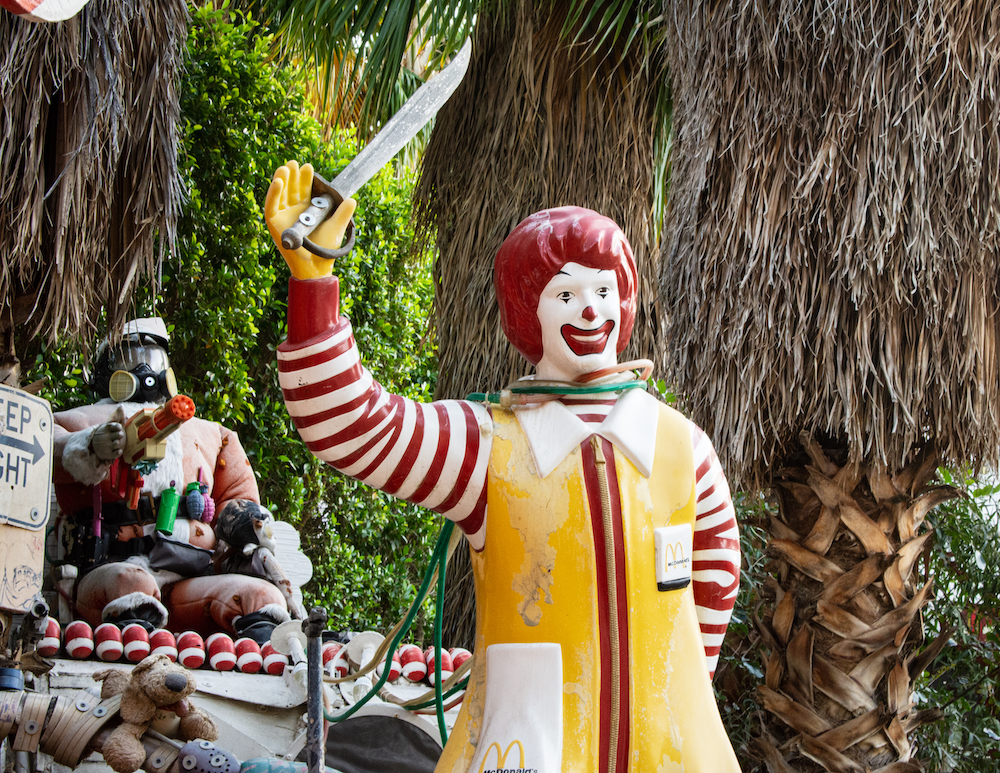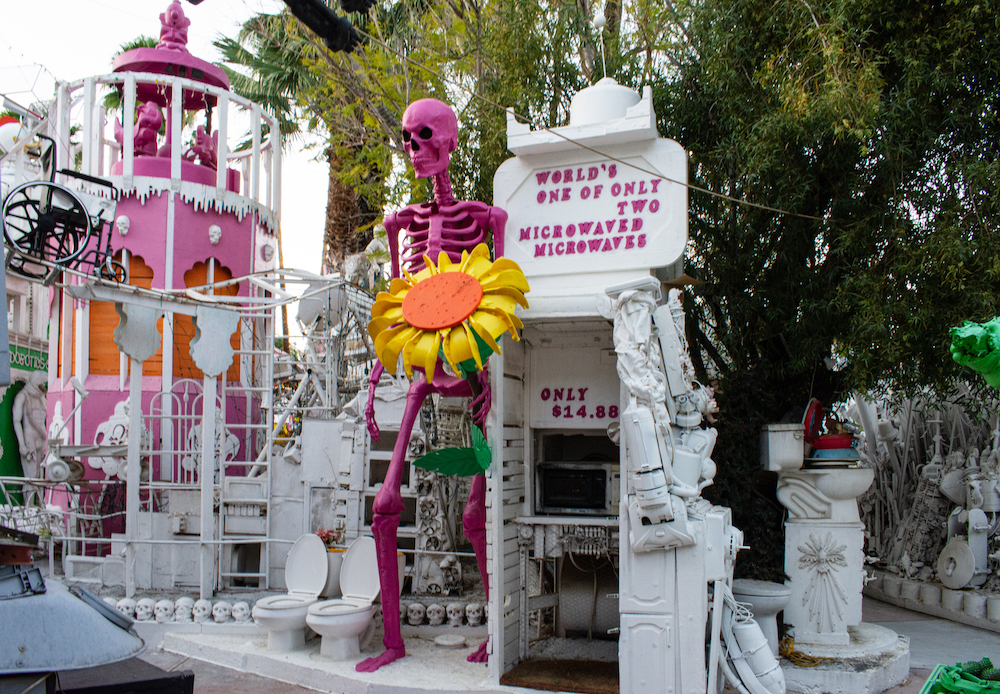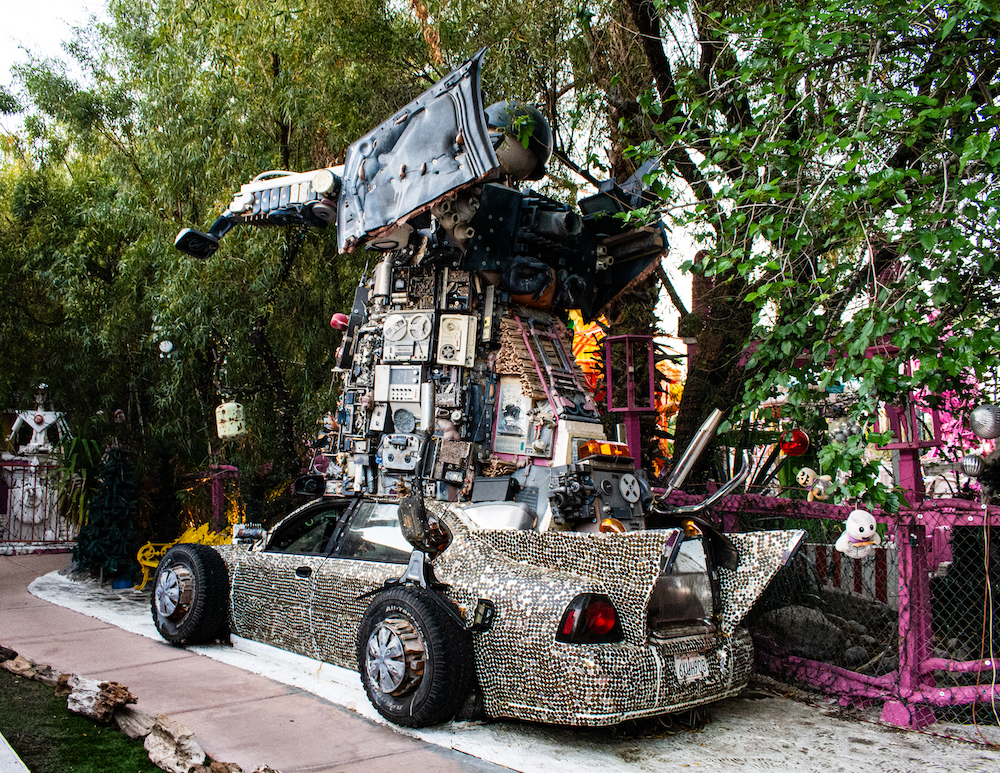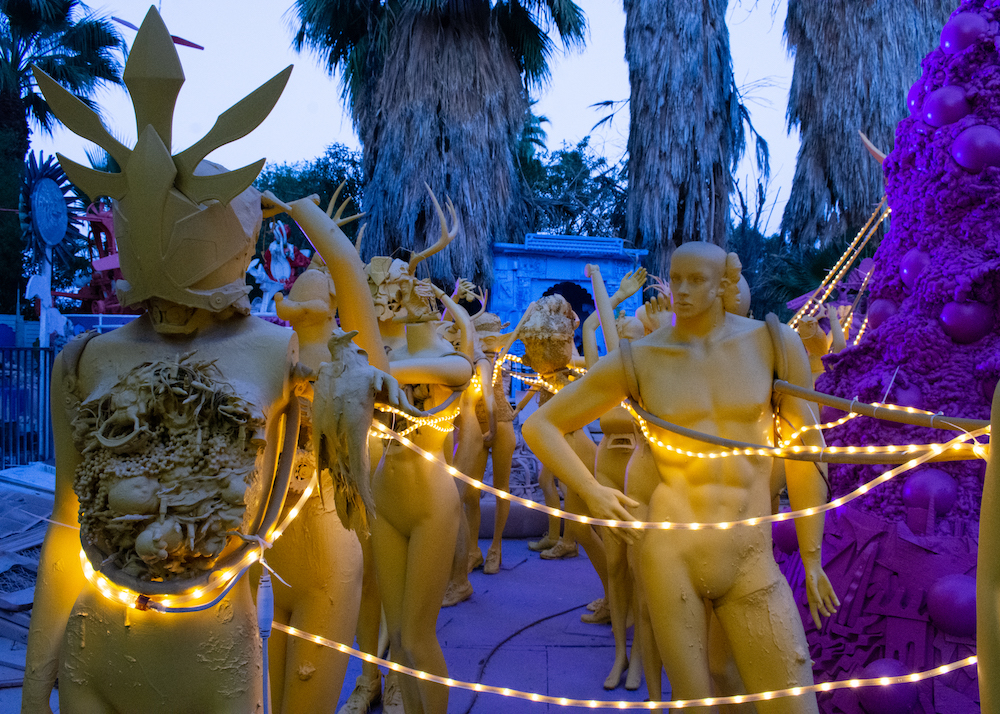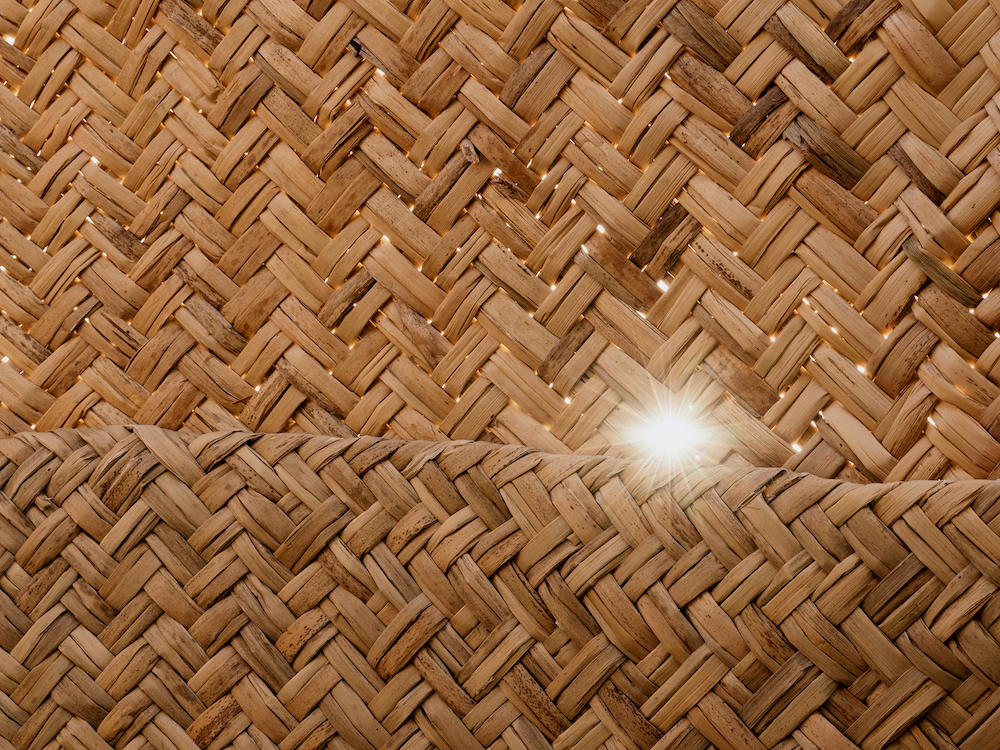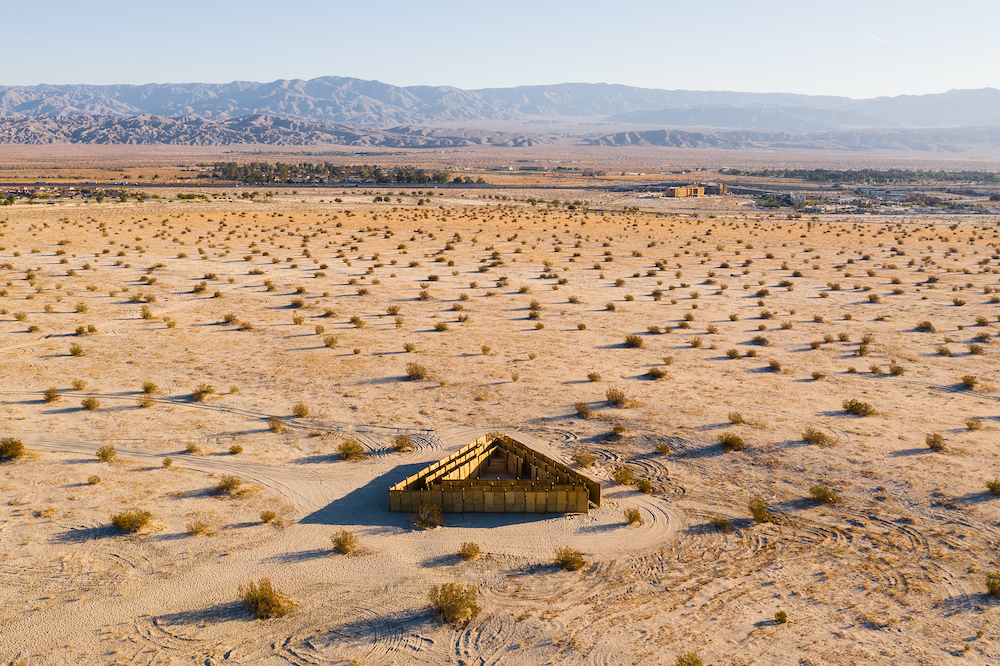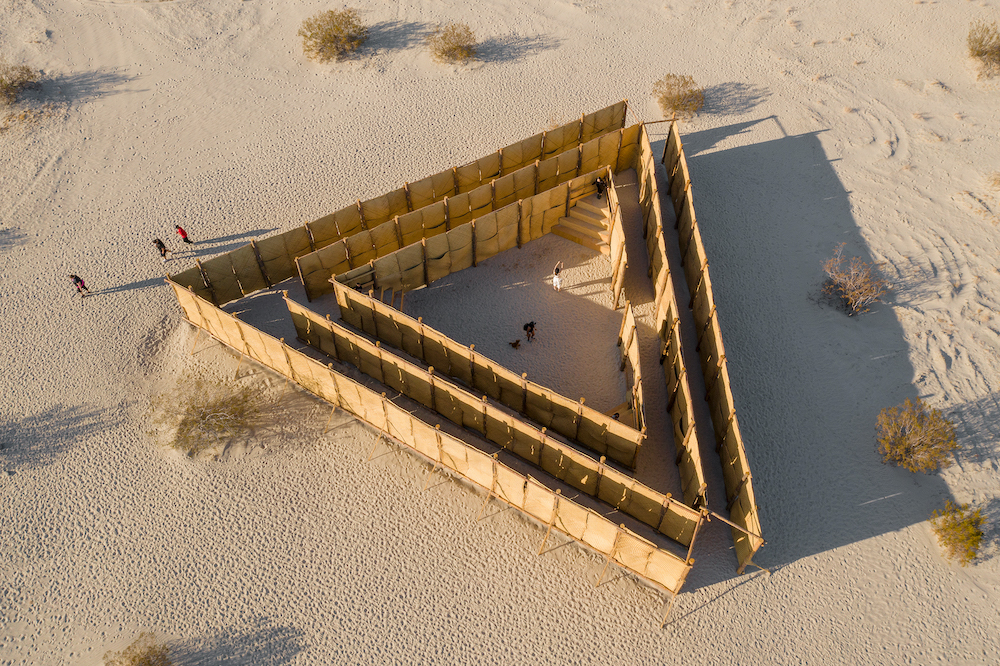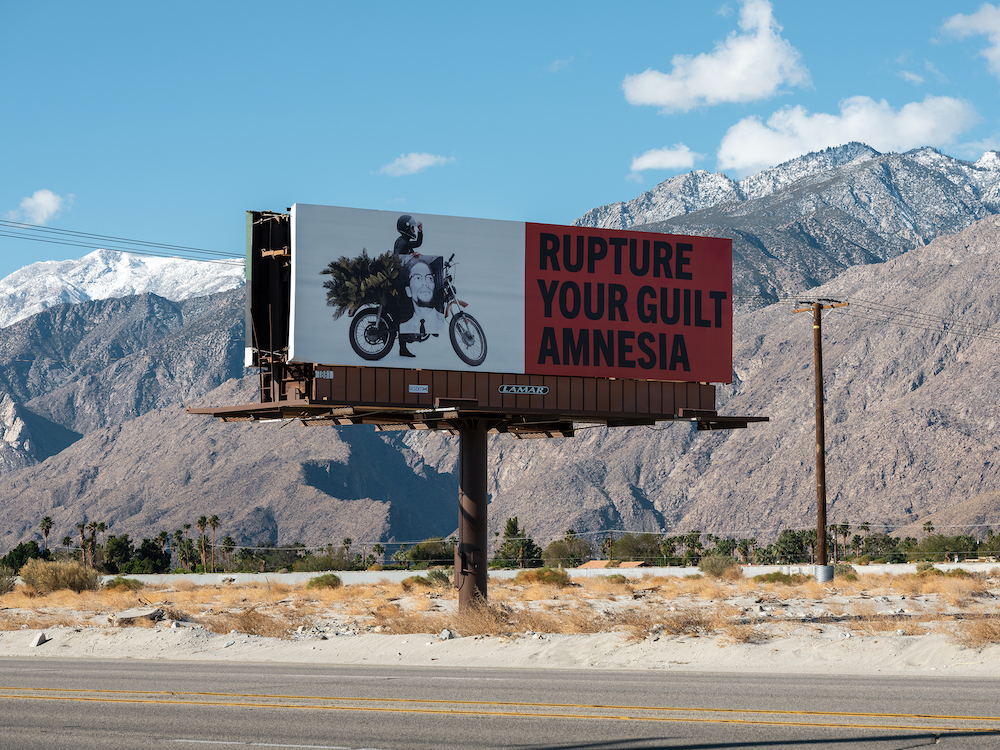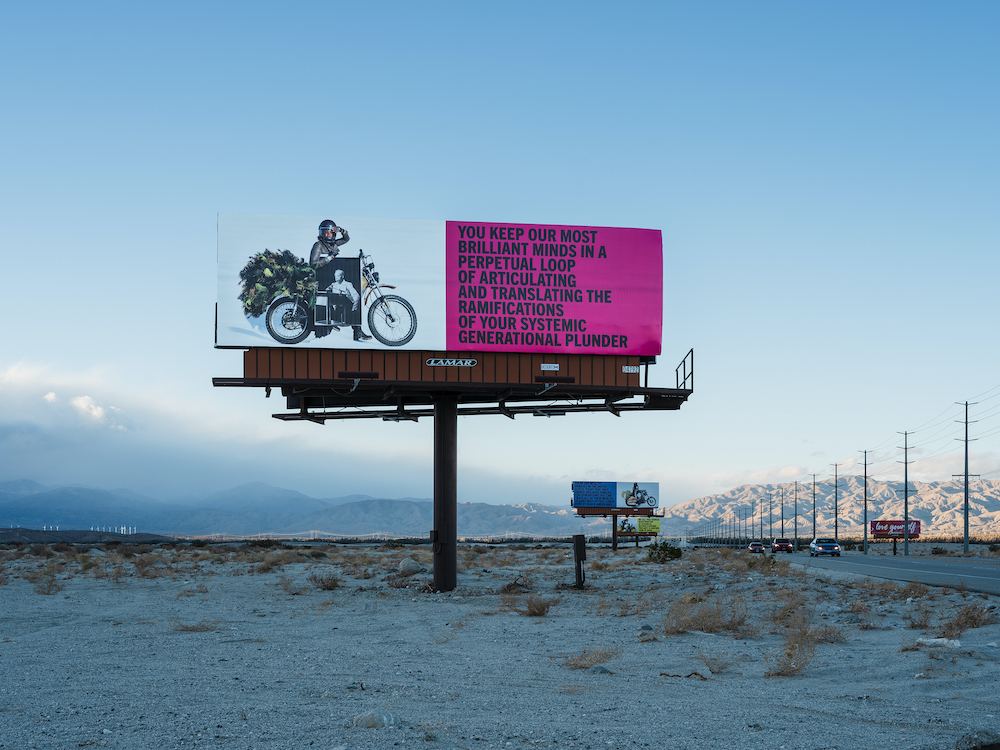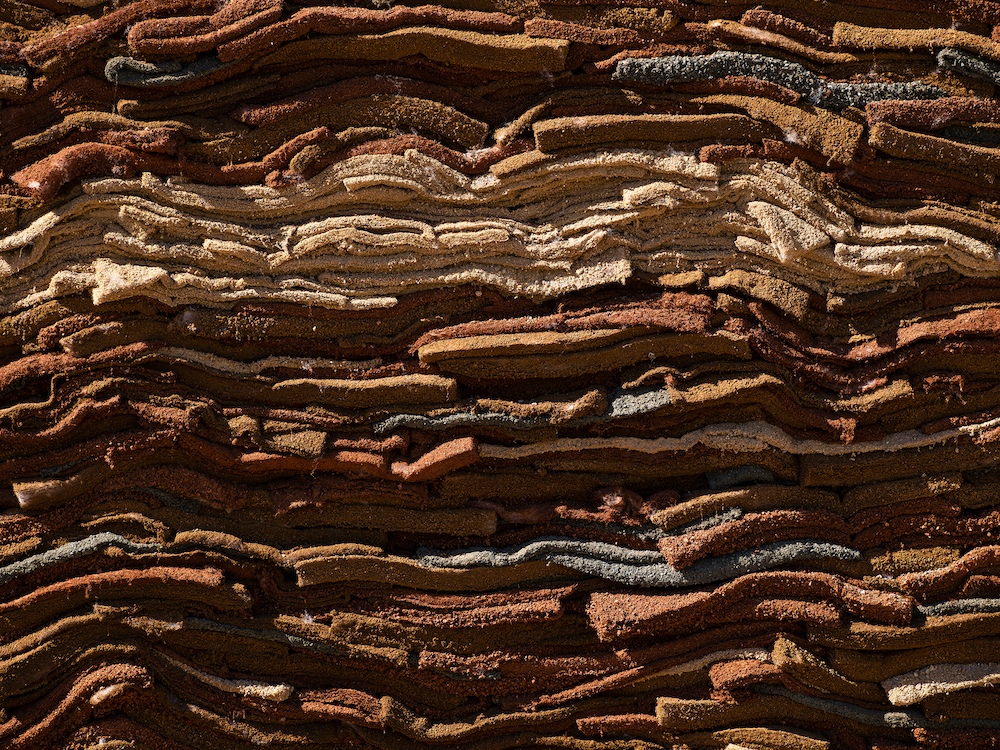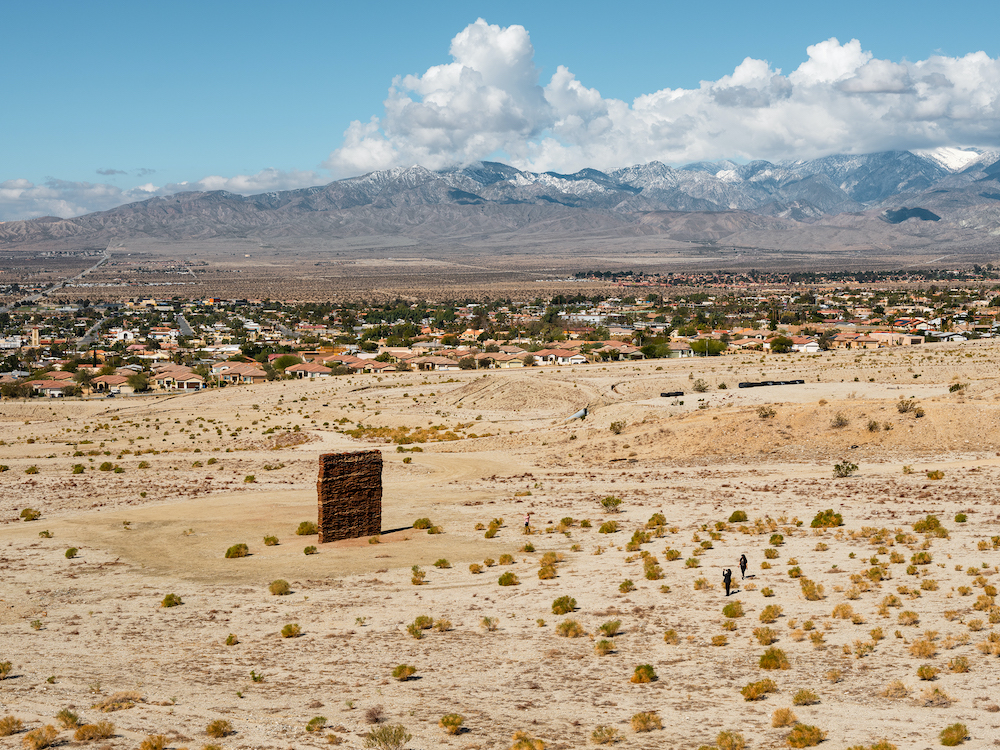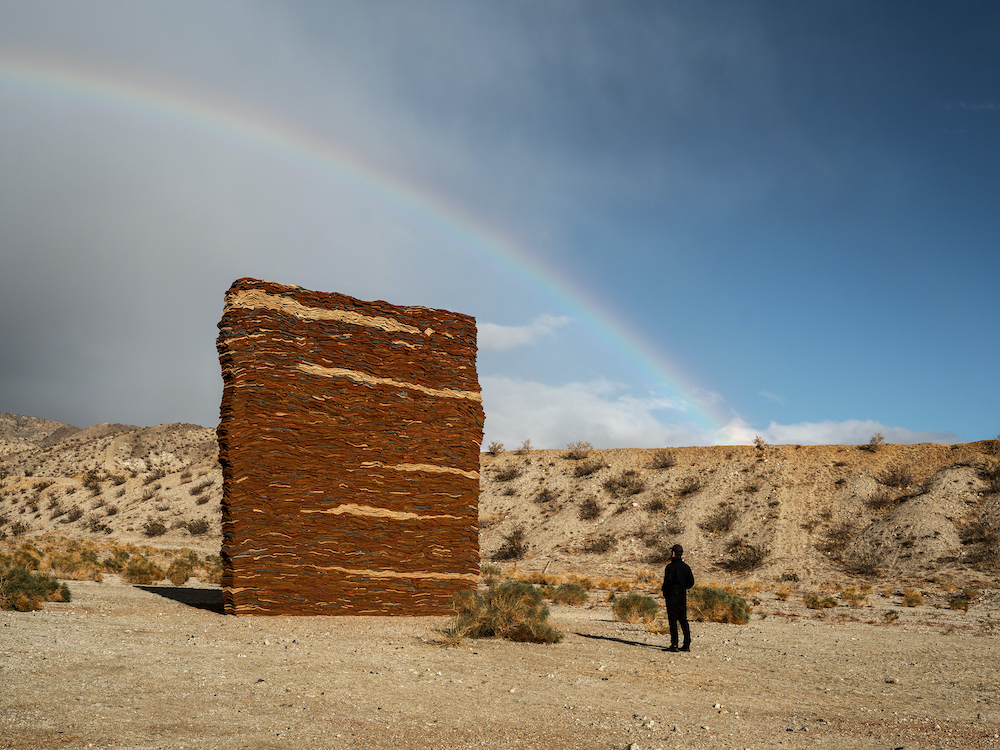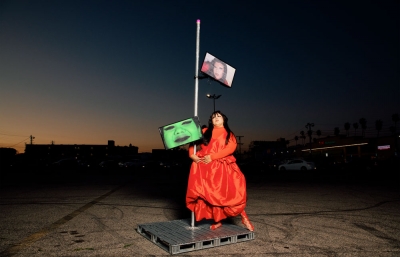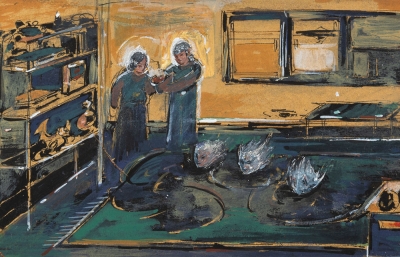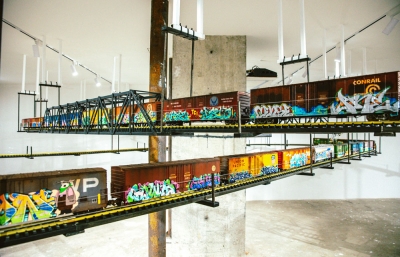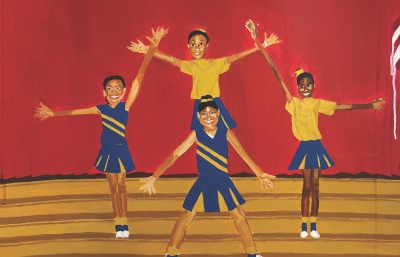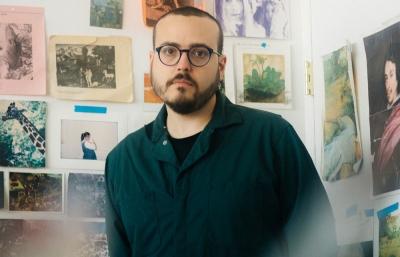Hot, brown desert stretches into the horizon. Craggy, snow-kissed mountains jut into a blue swimming pool sky. Behind us, massive white turbines slice through the air—their rhythmic rotations kicking up dust devils that begin at our feet and waft upwards into our mouths. Hair whips in the wind, and a Jeep that matches the sky holds court in the foreground.
From another camera angle, we might have been art influencers pulling over to the “soft shoulder” (a term we’d later learn) of the road for a selfie, except that my friend Jess and I are on all fours (all eights?), chest deep in sand, shoveling out the undercarriage of her early-2000s SUV like dogs digging for a bone. There is an actual dog, an 11-year-old cockapoo named Charles, inside the car looking, eyeing us with proper skepticism.
We are still miles from our destination—a massive, scavenger-style exhibition spread across the arid Mojave near Palm Springs, California, known as Desert X. It’s the first day of what ostensibly began as an assignment to cover the first major outdoor art exhibit since BC, but quickly turned into an adventure ignited by discovering art in unexpected places.
The Great Artdoors
Whether you call it Land Art, Earth Art or site-specific work, art that exists outdoors is as old as time. The singular power of wide-open spaces as blank canvas has spurred countless works—entire communities, even—representing a diverse range of points on the high-low spectrum, from refined, heavily funded projects to ethereal outsider art. Examples include Robert Smithson’s seminal Spiral Jetty in Utah and Storm King Center in Upstate New York, both seminal patrons of the outdoor arts. Here in southern California, you’ll find Leonard Knight’s Salvation Mountain, Slab City’s East Jesus, Noah Purifoy’s Desert Art Museum and the Bombay Beach art community.
A biennial exhibit launched in 2017, Desert X is a relatively new addition to that canon, but its third edition arrives at the beginning of an important cultural shift as most of the population has spent the better part of a year indoors surrounded by screens, internalizing a constant stream of the horrible and the beautiful. Art has not escaped the scourge of Covid’s IRL casualties. Barring an early wave of “online viewing rooms” (websites) and the occasional by-appointment gallery visit, most folks have not experienced physical art in a meaningful way since last March.
And now, at the exact moment the real world is beginning to open back up, the virtual world, which art lovers have been forced to consume, has reached a fascinating boiling point in the form of the $69M sale of a non-fungible token, or NFT—art that, literally, is not real.
Collectively, all of these factors set the perfect stage to, well, make people want to go outside. So that’s what I did.
33.4803.3, -116.32230: Ace Hotel, Palm Springs
My escapade begins on a hot Saturday morning at the Ace Hotel in Palm Springs, the official hub of Desert X, where Jess and I follow a path of pink arrows to an information booth stationed next to the bowl of hipster soup that is the swimming pool.
This year’s edition, I learned, was co-curated by Neville Wakefield and César García-Alvarez, and features installations by 12 artists representing 8 countries and a range of disciplines. Although more physically modest than previous iterations, the third Desert X is special in that the organizers were able to execute a large exhibit, supporting artists in the middle of a challenging pandemic, as well as create an opportunity to view art safely and admission-free at a time when people are hungry for a shared cultural experience.
“We have spent months seeing the pandemic as statistics and charts that dehumanize an embodied experience,” says García-Alvarez. “We need to have experiences that speak to our fears and desires that have shaped how we’ve navigated the past year. There are not many things that bring us closer to these big questions and to those, both like us and unlike us, than art.”
Desert X began with the goal of exploring the relationship between art and the desert. But it has always been as much about the active process of viewing the work, which requires downloading an interactive app that points to each location. A scavenger hunt in the sun!
“At a time when most art institutions remain shuttered or operating at a greatly reduced capacity,” says Wakefield, “a non-prescriptive, self-guided show that occupies open spaces has allowed Desert X to be one of the first significant shows to open here in the U.S. and, for artists and audiences alike, signals a return to the kind of experiences we have all so sorely missed.”
33.775917, -116.368694: The Passenger
We begin by navigating Eduardo Sarabia’s The Passenger, an arrow-tip shaped maze made from petates, rugs woven from palm fibers. The installation is inspired by a fitting trope for the first stop on a desert journey, as we’re greeted by a chatty masked docent who asks us to channel the pilgrimages our ancestors endured on the Oregon Trail as we amble through the maze “in our cute shoes with our cute dog.” Feeling dutifully respectful of our ancestors and in full agreement that Charles is very cute, we look askance at our humble, scuffy shoes and work our way to the center of the maze, where we soak up sweeping views of the desert from some bleachers and smile at a local motorcycle club gleefully posing for group photos.
Coordinates Unknown: Sky Valley
This brings us to the digging. What would cause someone to spend the bulk of the first day of a work assignment in a ditch on the side of a highway? It certainly made sense at the time. Who wouldn’t be curious and make a quick stop to examine a fallen, strangely beautiful turbine propeller the size of a small airplane? Unfortunately, what starts as an exercise in seeking out art in unexpected places can turn into an unsuccessful exercise in offroading. This impulse, combined with some deceivingly soft sand and a refusal to call AAA, will result in 45 minutes of digging.
33.964250, -116.484250: Morongo Valley
Hot and dirty but free, we picked up some Red Vines, a bag of ranch Doritos and a roadie michelada to fuel a short drive to What Lies Behind the Walls by Saudi Arabian artist Zahrah Alghamdi. After a windy, quarter-mile hike into the desert, we’re rewarded with one of Desert X’s most impactful installations, a monolithic sculpture constructed from layers of fabric and cement that smell like dirt but look like the tower of mattresses in The Princess and the Pea. Recognizing the similarities between the California and Saudi Arabian deserts, the piece illustrates the relationship between the art and the land through a unique combination of scent, texture and ideas. It’s hard to imagine this installation existing anywhere else.
34.15660549168434, -116.493103231107: Pioneertown
Tired from digging, we abandon plans for a sunset session at the Integratron sound bath for more micheladas at the famous Joshua Tree watering hole, Pappy & Harriet’s. In addition to knoshing on a delicious pile of nachos, art shows up in the form of a local band and the unexpected opportunity to hear live music for the first time in over a year. After a few drinks with Jess and a few dances with Charles the dog, I return to my car and drive alone to Palm Springs just as the setting sun transforms the Joshua Trees into silhouettes.
33.822172517037764, -116.54223719952763: Downtown Palm Springs
For the next two days, I explore Desert X alone. Standout artists include Xaviera Simmons, who created a series of billboards on Gene Autry Trail that fuse text and imagery into a challenging meditation on race. Being in the desert, while interacting with art in a community of people committed to understanding and imagination, strips away a few layers of covid debris from my psyche. But the more time I spend outdoors, the freer I want to feel. And though things like the Desert X “pit stop,” which is a Gucci- and North Face-sponsored dome minus a door, serve a valuable purpose by supporting a cultural moment, they don’t exactly feed the soul. So I stay.
33.822172517037764, -116.54223719952763: Downtown Palm Springs, Part II
I spend the next few days trying to surrender to the journey instead of planning the destination by beginning with relocating to what seems to be the only available accommodations in Palm Springs, a Tiki-themed suite at the Caliente Tropics Hotel. Other than a sleepless night caused by a large animal under my bed that turns out to be a sprinkler hitting the side of the building, it's a lovely place to stay, particularly after 2-3 magic mushroom gummies and a dirty martini from Melvyn’s steakhouse.
33.92524869574892, -116.54478514971049: North Palm Springs
The highlight of phase two of the adventure is a birthday celebration for my friend Steve Hash, an artist who makes beautiful sculptures of ghosts from concrete and terry cloth towels. The evening, fueled by copious amounts of tequila, includes a clever scavenger hunt led by Steve’s daughter, an impromptu jam session during which I learn to play three notes on the electric guitar, and a delicious seafood dinner, marred only by a crab-claw induced cut on my thumb.
The less I plan the trip, the more fun it becomes. The more fun it becomes, the longer I want to stay. The longer I stay, the more I realize that art experienced in this way makes me realize the important synergy of moment and place. This is true whether it's a sculpture by a blue chip artist, a living room hit with an explosion of birthday balloons after a few glasses of tequila, or the broken propeller of a turbine.
34.12013805923302, -116.43446540227208: Oasis of Eden, Yucca Valley
It’s the day before I head home to Los Angeles, and a Spring Break-fueled shortage of hotel rooms in Palm Springs leads me to Yucca Valley, a partially-gentrified hipster outpost of Palm Springs located near Joshua Tree (and Pappy & Harriet’s). Specifically, to a kitschy themed hotel called the Oasis of Eden that’s exactly charming (and clean) enough to warrant a one-night stay. I am ensconced in the “Swimmers Paradise” room, where I enjoy a two-hour session in my red en suite Jacuzzi beneath a ceiling wallpapered in a cloud-speckled sky that reminds me of that first day of the Big Dig.
33.83205792395526, -116.53540433296668: Robolights, Movie Colony, Palm Springs
My last stop is the best. Nestled in a community of mid-century modern mansions in the Movie Colony section of Palm Springs. Robolights is the outdoor art antithesis to the polished, hyper-curated Desert X. The brainchild of a primarily self-taught artist named Kenny Irwin Jr., Robolights is a sprawling compound of fantastical creations the artist began building in 1986 on the four-acre plot surrounding his childhood home.
The living installation, which Irwin Jr. works on between 8-10 hours a day, consists of a dense maze of interlocking pathways bordered by artworks made from found or donated objects that he has transformed into a psychedelic Wonkaland set to a soundtrack of campy classical music. There are 50-foot-tall robots, hot pink giraffe bots, a Christmas sleigh overtaken by a deranged Easter Bunny, post-apocalyptic “nuclear elves” prancing across a tennis court, and a village made entirely from microwaves.
According to Irwin Jr., Robolights isn’t a choice. He sees his creations in his dreams, resulting in work and identity that are synonymous: “It’s physiologically intertwined in my physiology. A cat is born to meow but it doesn’t know why it’s born to meow—it just meows… I don’t really know why I was made to be an artist, I just know that I was born that way.”
I learned about Robolights on a lark, from a friend of Jess’s who stopped for an impromptu hello while we were eating dinner in Palm Springs earlier in the week. I couldn’t believe I had never heard of something close by that had existed for so long.
So, on my last night in the desert, I text the artist from the red jacuzzi on impulse, driven by the same question that landed Jess and me in the ditch eight days earlier. And, of course, the answer is the same anytime Irwin Jr. is asked to explain what impels his art: “Why not?” —Liz Suman
This article was originally published in our Sumer 2021 Quarterly edition


